#imaginary architecture
Explore tagged Tumblr posts
Text
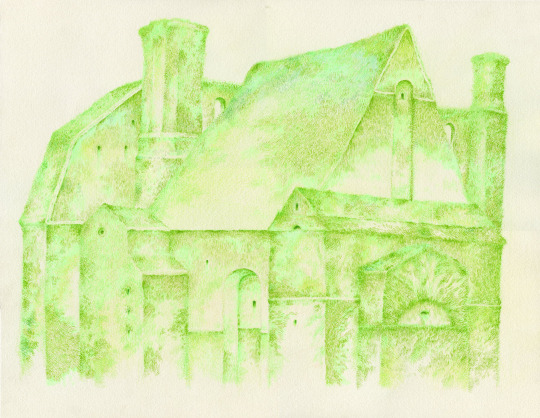
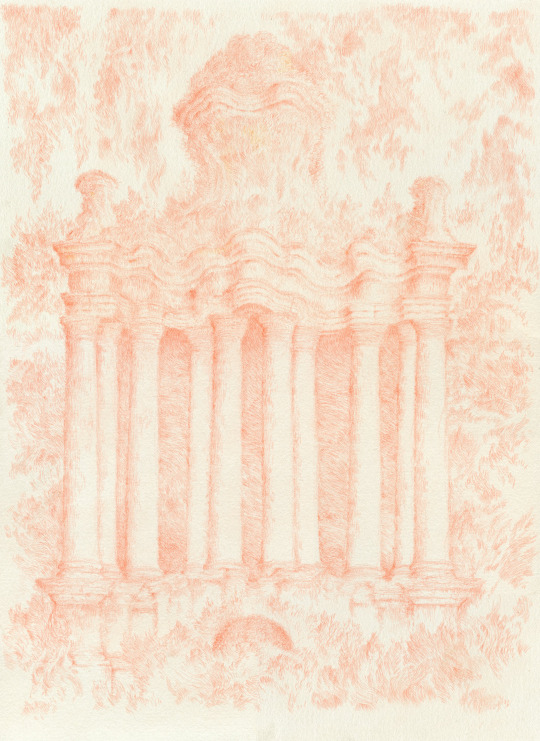
Here are two of my most recent drawings. I'm continuing to make highly colorful pieces, but for these I wanted to try working in a relatively monochromatic mode. The first was done using colored pencils and pens, while the other was just one colored pencil. It's been interesting to do these and see the resurgence of some mark-making and the application of negative space I mostly haven't used since doing large-scale landscape drawings in grad school.
#architectural drawing#architecture drawing#architecture#imaginary architecture#fantasy architecture#capriccio#visionary art#organic architecture#grotesque
84 notes
·
View notes
Text

Gilbert Adrian (1903-1959) Imaginary Architecture (undated) Source

African Dream (undated) Source

Tropical May Pole Scene (undated) Source

It Has Been a Fine Day (undated) Source

Feeding the Giraffes (undated) Source

Strange Africa (undated) Source

Tropical Street Scene (undated) Source

A Conversation About Marriage (undated) Source

Elephant (undated) Source

Imaginary Creature (undated) Source
#gilbert adrian#Imaginary Architecture#African Dream#Tropical May Pole#It Has Been a Fine Day#Feeding the Giraffes#Tropical Street Scene#A Conversation About Marriage#elephant#Imaginary Creature#oil on canvas
5 notes
·
View notes
Text

Lamentation by Jan Provoost, South Netherlandish, ca. 1510-1515
I LOVE the fantastical gothic architecture in the background
9 notes
·
View notes
Photo

Shipping Deck by Calder Moore via r/ImaginaryCyberpunk
#calder moore#shipping deck#art#illustration#cyberpunk#scifi#r/imaginarycyberpunk#imaginary cyberpunk#reddit#aesthetic#industrial#architecture#concept art
575 notes
·
View notes
Text
"The most fashionable bathing station in all Europe". British industrialists and American mining investors plotting the colonization of the Congo, while mingling at Ostend's seaside vacation resorts. Extracting African life to build European railways, hotels, palaces, suburbs, and other modern(ist) infrastructure. "Towards infinity!"
---
In 1885, King Leopold II achieved an astonishing and improbable goal: he claimed a vast new realm of his own devising, a conjury on a map called [...] the Congo Free State. [...] [A] fictional state owned by the king, ruled by decree, and run from Brussels from 1885 to 1908. [...] This was [...] a private entrepreneurial venture [for the king]. The abundance of ivory, timber, and wild rubber found in this enormous territory brought sudden and spectacular profits to Belgium, the king, and a web of interlocking concession companies. The frenzy to amass these precious resources unleashed a regime of forced labor, violence [millions of deaths], and unchecked atrocities for Congolese people. These same two and a half decades of contact with the Congo Free State remade Belgium [...] into a global powerhouse, vitalized by an economic boom, architectural burst, and imperial surge.
Congo profits supplied King Leopold II with funds for a series of monumental building projects [...]. Indeed, Belgian Art Nouveau exploded after 1895, created from Congolese raw materials and inspired by Congolese motifs. Contemporaries called it “Style Congo,” [...]. The inventory of this royal architecture is astonishing [...]. [H]istorical research [...] recovers Leopold’s formative ideas of architecture as power, his unrelenting efforts to implement them [...]. King Leopold II harbored lifelong ambitions to “embellish” and beautify the nation [...]. [W]ith his personal treasury flush with Congo revenue, [...] Leopold - now the Roi Batisseur ("Builder King") he long aimed to be - planned renovations explicitly designed to outdo Louis XIV's Versailles. Enormous greenhouses contained flora from every corner of the globe, with a dedicated soaring structure completed specifically to house the oversize palms of the Congolese jungles. [...]
---
The Tervuren Congo palace [...]. Electric tramways were built and a wide swath of avenue emerged. [...] [In and around Brussels] real estate developers began to break up lots [...] for suburban mansions and gardens. Between 1902 and 1910, new neighborhoods with luxury homes appeared along the Avenue [...]. By 1892, Antwerp was not only the port of call for trade but also the headquarters of the most profitable of an interlinking set of banks and Congo investment companies [...]. As Antwerp in the 1890s became once again the “Queen of the Scheldt,” the city was also the home of what was referred to as the “Queen of Congo companies.” This was the ABIR, or Anglo-Belgian India Rubber Company, founded in 1892 with funds from British businessman “Colonel” John Thomas North [...].
Set on the seaside coast, Belgium’s Ostend was the third imperial cityscape to be remade by King Leopold [...] [in a] transformation [that] was concentrated between 1899 and 1905 [...]. Ostend encompassed a boomtown not of harbor and trade, like Antwerp, but of beachfront and leisure [...] [developed] as a "British-style" seaside resort. [...] Leopold [...] [w]as said to spend "as much time in Ostend as he did in Brussels," [...]. Ostend underwent a dramatic population expansion in a short period, tripling its inhabitants from 1870–1900. [...] Networks of steamers, trams, and railway lines coordinated to bring seasonal visitors in, and hotels and paved walkways were completed. [...] [A]nd Leopold’s favorite spot, the 1883 state-of-the-art racetracks, the Wellington Hippodrome. Referred to with an eye-wink as “the king incognito” (generating an entire genre of photography), visitors to the seaside could often see Leopold in his top hat and summer suit [...], riding his customized three-wheeled bicycle [...]. By 1900, Ostend’s expansion and enhancement made it known as “the Queen of the Belgian seaside resorts” and “the most fashionable bathing station in all Europe.” Opulence, convenience, and spectacle brought the Shah of Persia, American tycoons, European aristocrats, and Belgian elites, among others, to Ostend.
---
Leopold’s interventions and the Congo Free State personnel and proceeds played three pivotal and understudied roles in this transformation, all of which involved ABIR [British industrialists].
First, it was at Ostend that an early and decisive action was taken to structure the “red rubber” regime and set it in motion. In 1892, jurists such as [E.P.] had ruled, contravening [...] trade laws, that the king was entitled to claim the Congo as his domanial property [...]. Leopold [...] devised one part of that royal domain as a zone for private company concessions [...] to extract and export wild rubber.
Soon after, in 1892, King Leopold happened to meet the British “Colonel” John Thomas North at the Ostend Hippodrome. North, a Leeds-born mechanic [...] had made a fortune speculating on Chilean nitrates in the 1880s. He owned monopoly shares in nitrate mines and quickly expanded to acquire monopolies in Chilean freight railways, water supplies, and iron and coal mines. By 1890 North was a high-society socialite worth millions [...]. Leopold approached North at the Ostend racecourse to provide the initial investments to set up the Anglo-Belgian India Rubber Company (ABIR). [...]
---
One visible sign of Ostend’s little-known character as Congo boomtown was the Royal Palace Hotel, a lavish property next to the king’s Royal Domain, which opened in 1899. With hundreds of rooms and a broad sweep of acreage along the beachfront, the palace “occupied the largest space of any hotel in Europe.” [...]
King Leopold met American mining magnate Thomas Walsh there, and as with North, the meeting proved beneficial for his Congo enterprise: Leopold enlisted Walsh to provide assessments of some of his own Congo mining prospects. The hotel was part of [...] [a major European association of leisure profiteers] founded in 1894, that began to bundle luxury tourism and dedicated railway travel, and whose major investors were King Leopold, Colonel North [...].
At the height of Congo expansionism, fin-de-siècle Antwerp embodied an exhilarated launch point [...]. Explorers and expeditioners set sail for Matadi after 1887 with the rallying call “Vers l’infini!” (“towards infinity!”) [...].
---
Text above by: Debora Silverman. "Empire as Architecture: Monumental Cities the Congo Built in Belgium". e-flux Architecture (Appropriations series). May 2024. At: e-flux.com/architecture/appropriations/608151/empire-as-architecture-monumental-cities-the-congo-built-in-belgium/ [Bold emphasis and some paragraph breaks/contractions added by me. Italicized first paragraph/heading in this post was added by me. Presented here for commentary, teaching, criticism.]
#tidalectics#ecology#multispecies#abolition#this full article has far more info about leopolds obsession with opulence and all the many infrastructure projects in belgium he sponsored#full article also expands more on congolese art and anticolonial art projects that criticize belgian architecture#eflux did several articles focusing on anticolonial responses to belgian extraction and art noveau and modernist architecture#including a piece on spectacle of belgian worlds fair and human zoos#silverman has very extensive research history#ecologies#geographic imaginaries
132 notes
·
View notes
Text
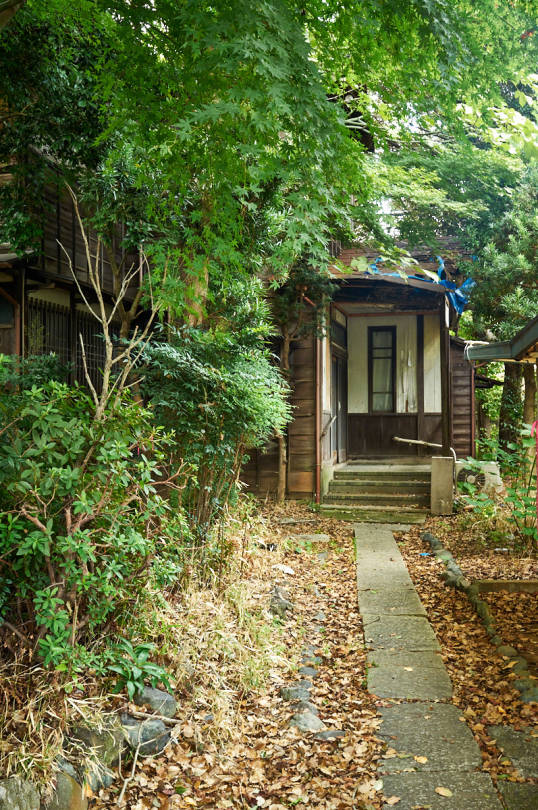
Bulldozed Fantasies:
This old Showa era house nearby was a hidden gem. Barely visible through the trees that surrounded it, it was an old wooden structure of the type disappearing in Tokyo (largely due to earthquake and fire regulations) that reminded me of something out of Tonari no Totoro. It even had signs that Meguro ward recognized some of the trees there as worthy of preservation.
Alas, as Tonari no Totoro is a fantasy, the idea that Meguro would preserve those trees, let alone the house itself is too. The last I saw of it in November, it was a cleared dirt lot with a few scraggy trees not yet removed. My fantasy---as always an absurd fantasy---of somehow living in a house like that in Tokyo took a hit. Then, observing what the January 1 earthquake in Isahikawa did to such old wooden houses with heavy tile roofs, my fantasy disappeared forever.
#japanese houses#showa era houses#original photographers#photographers on tumblr#small town tokyo#japanese architecture#japanese aesthetics#tokyo#japan#fantasies#imaginary japan
196 notes
·
View notes
Text

“Welcome to Tribuneville.” Photo © Michael Salisbury.
A Futuristic 150-Foot Installation Imagines Chicago’s Never-Built Architecture
With its long vertical lines and neo-Gothic features, the architectural marvel that is Tribune Tower in Chicago has an unorthodox origin story. Home to the newspaper’s operations, the now-iconic building resulted from an international competition hosted in 1922 by the co-publishers. More than 260 architects from 23 countries submitted designs that would house the newspaper, with New York-based John Mead Howells and Raymond Hood ultimately winning the bid.
A project by architectural cartoonist Klaus and MAS Context brings this history to light. “Welcome to Tribuneville: An Imaginary Vision of an Old Chicago That Could Have Been” features 60 drawings of never-made buildings submitted to the contest installed at 150 Media Stream. Located in the lobby of 150 N. Riverside Plaza, the installation has featured several digital works across its 89 LED blades since 2017.
All images courtesy of 150 Media Stream and MAS Context

Detail of “Welcome to Tribuneville.”




#tribune tower#chicago#illinois#futuristic 150-foot installation#architecture#150 media stream#mas context#michael salisbury#klaus#architectural cartoonist#Welcome to Tribuneville: An Imaginary Vision of an Old Chicago That Could Have Been#art installation
7 notes
·
View notes
Text
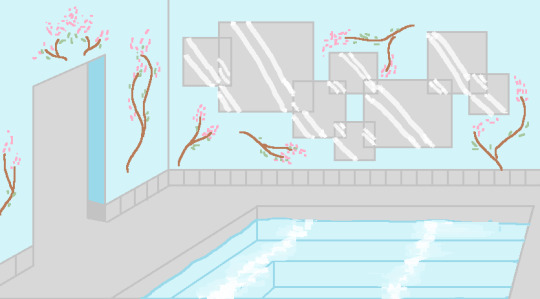
i'd like to take a dip here 🌸
41 notes
·
View notes
Text

For one of my recent exhibitions, a friend helped me build a bunch of frames, and he asked that I do a piece for him in return. I went for something similar to the colorful work I was making during the later months of last year, drawing on a mixture of shingle style and farm buildings. The linework was done using a bunch of different ink pens, and most of the color comes from watercolor paints. In my head, I had the image of a building which appeared to progress from a summery to an autumnal palette, as if the building were alive and getting ready for fall alongside the surrounding plant life.
#architecture#shingle style#farm#barn#architectural drawing#architectural painting#fantasy architecture#imaginary architecture#capriccio#organic architecture
12 notes
·
View notes
Text
How it feels to have to work on your own projects if you want them to actually get done

#AUGHHHH I’m fucking working on backgrounds and building interiors for Wilt&Wish and it’s dragggiiiinnggg#colors are hard ;-; architecture is hard ;-; but I remain determined….#just part of the learning curve….. *inhales imaginary cigarette *
5 notes
·
View notes
Text
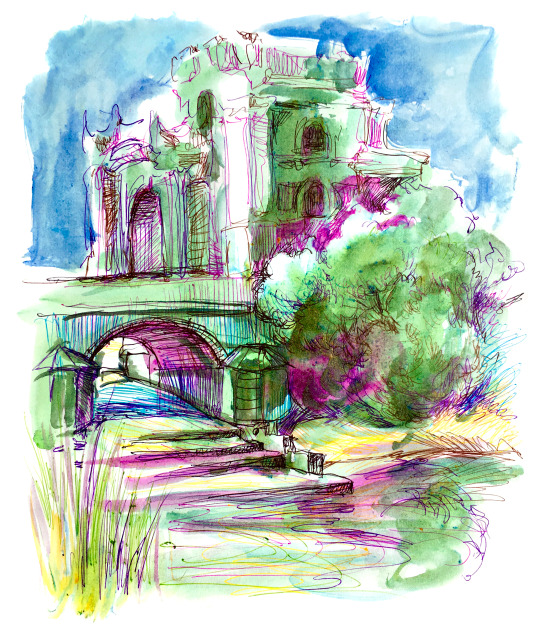
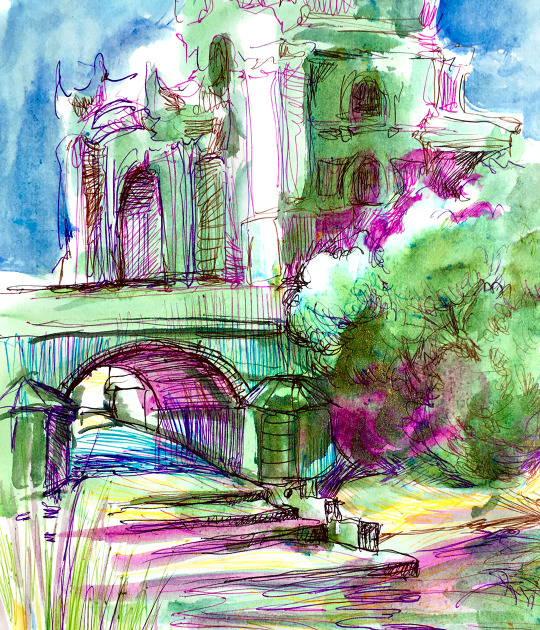
Yay, I've done it again! Half a plein air, half a fantasy🏰 The dam though is quite real and also very walkable should one feel inspired to stroll around those ponds. The technique is going wild with a mix of powder paints and colourful pens🎨
#plein air#river dam#dam#levee#dyke#imaginary#architecture#experiment#summertime#green#mixed media#coloured pens
3 notes
·
View notes
Text
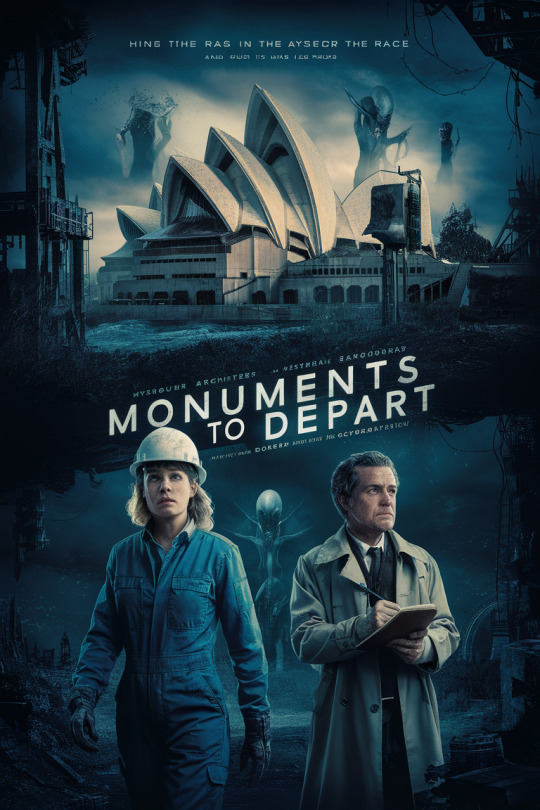
Prompt: On a future earth where human population is slowly dwindling, aliens have been buying buildings with iconic architecture. The various governments happily divest themselves in the face of the aliens' stated interest in restoring the buildings. Unfortunately, the restoration is intended to turn them into spaceships. Create a movie concept based on this.
Title: Monuments to Depart
Logline: In a future where humanity dwindles and iconic structures become relics, a cynical architect and a curious historian uncover the truth behind a mysterious alien race’s obsession with Earth’s landmarks – they’re not restoring the buildings, they’re building spaceships.
Characters:
Evelyn "Eve" Wright (40s): A jaded architect with a sharp wit and a waning passion for her profession. Facing a dwindling pool of clients, she reluctantly accepts a government contract to "oversee" the alien restoration of the Sydney Opera House.
Dr. Kai Tanaka (30s): A brilliant but ostracized historian, obsessed with the enigmatic messages left behind by the aliens. He believes their interest in Earth's architecture goes beyond mere restoration.
Xylo (Voice Only): The stoic leader of the alien race, communicating through a series of clicks and whistles translated by a complex AI program. Their motives remain shrouded in mystery.
Anya Petrova (60s): A seasoned government official tasked with maintaining relations with the aliens. She struggles with the pressure to keep the peace and her own growing suspicions about the project.
Plot Summary:
Earth’s population has dwindled. Cities stand partially abandoned, their iconic landmarks echoing with a forgotten past. Enter the Xylosians, an enigmatic alien race who arrive with a surprising proposition – they want to purchase and restore Earth's most celebrated buildings. Cash-strapped governments, eager to shed the burden of maintenance and intrigued by the potential for renewed cultural exchange, readily agree.
Evelyn Wright, a once-idealistic architect now hardened by years of dwindling projects, becomes the government's liaison for the "restoration" of the Sydney Opera House. However, she soon finds the Xylosians' methods unorthodox – their focus is on functionality, not aesthetics.
Meanwhile, Dr. Kai Tanaka, a historian ostracized for his fringe theories, becomes obsessed with the cryptic messages left behind by the Xylosians. He believes the aliens are not restoring the buildings, but repurposing them. His research leads him to a shocking conclusion – the aliens are using the landmarks as blueprints for massive spaceships.
Evelyn, initially skeptical of Kai's theories, joins forces with him when she stumbles upon a hidden chamber within the Opera House, revealing advanced alien technology. Anya Petrova, the government official, initially dismisses their concerns, but mounting evidence and the increasingly hostile behavior of the Xylosians force her to confront the truth.
The climax arrives as the Xylosians activate the Sydney Opera House, its iconic shells transforming into a colossal spacecraft. Evelyn, Kai, and Anya, with the help of a sympathetic AI translator, scramble to stop the launch. They devise a desperate plan, using their knowledge of the buildings' architecture and Kai's understanding of the alien messages, to disrupt the launch sequence and expose the Xylosians' true intentions.
Themes:
The value of history and the importance of preserving the past.
The dangers of blind faith and the need for critical thinking.
Humanity's resilience and the power of collaboration in the face of overwhelming odds.
Visual Style:
The film utilizes a mix of stunning visuals and a slightly melancholic tone. The once-vibrant cities are depicted as eerily beautiful, highlighting the juxtaposition of crumbling infrastructure and advanced alien technology. The alien spaceships, constructed from repurposed landmarks, are visually awe-inspiring but carry a sense of unsettling beauty.
Monuments to Depart is a thought-provoking sci-fi adventure with a touch of mystery and intrigue. It's a story about facing the future while remembering the past, and the unexpected ways humanity can find hope and unity even on the brink of an alien invasion.
#ai generated#google gemini#imaginary movie#shitpost#stupid ideas#movie poster#poster#genre: thriller#genre: science fiction#post apocalyptic#soft apocalypse#societal collapse#iconic architecture#australia#sydney opera house#aliens#conspiracy#historical preservation#female protagonist
1 note
·
View note
Text
[A] team of technicians [is] working under sub-contracts for the National Mapping Agency [of Indonesia] to draw squares and rectangles around vast swaths of building and property across the archipelago. [...] [They] draw a perimeter [...] on the island of Kalimantan, a region that has witnessed the world's fastest forest clearing rates since 2012, as the oil palm [plantation] sector has expanded across rural Indonesia. [...] Even if state agency scientists demand that every building is drawn, his supervisors are afraid that the technicians will interpret too much. [...] [Bureaucrats] shrugged [...], reasoning that maps are crucial for Indonesia’s “pembangunan” (development), an ever-shifting ideology that has haunted the nation since [...] the 1950s. [...]
---
The contract employing the technicians stemmed from an incident in December 2010, when former Indonesian President Susilo Bambang Yudhoyono compared two conflicting maps of Papua Island. The two forest maps, one published by the Ministry of Forestry and the other by the Ministry of Environment, were presented in a cabinet meeting regarding [...] nationwide [...] plantation permits in primary forests. Each map showed primary forests of different sizes and boundaries. [...] A scandal broke out, with environmentalists claiming that these discrepancies are an example of how corrupt officials manipulate maps and issue plantation permits on protected forest land. Earlier in 1998, Indonesia’s timber and oil palm industry became increasingly decentralized and privatized. [...] Under a 2016 Presidential Decree, Indonesia’s National Mapping Agency [...] accelerate[d] the remapping of Indonesia’s 18,309 islands. [...] The base map [...] [is] conventionally understood as a “ground truth” to physical reality [...].
Yet, senior bureaucrats of the National Mapping Agency have always been aware that maps could never represent the real world. The agency’s Deputy Director recently stated to the Indonesian press that data on palm oil plantation ownership is “secret.”
Herein lies a tension between desires to conceal deforestation and the official appearance of attempts to reveal what’s happening on the ground. The accuracy of forest maps [...] [and a] map’s legibility can also be understood as part of a measured and managed public revelation and the concurrent concealment of information, narratives, and images of the trees that still stand. [...]
---
[S]ocial orders are based on "public secrets": forms of knowledge that are generally known insofar as they must not be overtly acknowledged. Simply put, one has to know what not to know.
Public life, its discourse, and practice, then, depend upon the management of transgression.
In Indonesia, it was understood that forest maps contained inaccuracies. From the fixed borders that enabled industrial plantation expansion to the inconsistent mapping standards, state maps were dissimilar all the way down. [...]
The pursuit of different versions of correspondence between territory and map segregates who gets to see and who gets to know what makes a forest. [...]
---
Bureaucrats have advanced data science projects to automate the delineation of forest borders, to know the forest in precise ways that crowd out what for others is actually there. [...] [Previously, technicians] had spent hours determining what pixel makes the cut. Perhaps drawing in this green pixel matches the vegetation nearby; perhaps adding a brown pixel grants more property for the house owner. The blur in the images makes for a deliberation that also implicates his wrists and fingers that grow sore from his tactful eyes. [...] Indeed, “there are no straight lines” on the edges of Kalimantan’s forest; someone feels these borders into vision. [...]
Data science initiatives, on the other hand, draw borders without explanation to remove this interpretive labor. [This process maps land by taking satellite photos, and then letting the automated model predict the extent of forest, removing the human interpretation and confirmation.] [...] Points are converted into labeled pixels and fed into models that in turn label points anew: points feed points. Unlike the field survey, with data science, ground truth is found within the image, not in the forest.
---
Indonesia’s forests are seen and known by different techniques. [...] Yet in keeping with the public secret of how forests are seen and governed by the state, each of these techniques also cultivates a willful not knowing.
Against the backdrop of the decades-long expropriation of indigenous land by patronage networks between timber and palm oil firms and central and district officials, broader shifts to institute efficiency and automation in mapping enable bureaucrats to relinquish their knowledge of such inconvenient truths. These technical initiatives recast the mapping of Indonesia as a preemptive activity [...]. The task of knowing what not to know emerges not only from the discursive theater of public human affairs, but out of the contest between the design and deployment of various mapping systems [...].
Is it possible to capture the world without seeing it? Or, who’s watching when a tree falls? Perhaps it doesn’t matter who, but how that watching is designed into a system that preempts a forest [...].
---
Text by: Cindy Lin. "How to Make a Forest". e-flux Architecture (At the Border series). April 2020. [Bold emphasis and some paragraph breaks/contractions added by me.]
40 notes
·
View notes
Text
100 Vocabulary Words for Gothic Fiction | For Writers

Hello Writers! I've put together a list of 100 words to help you expand your vocabulary for writing gothic fiction in October. I categorized the words for easy reference. I did some research using thesauruses and dictionaries to compile this list for you. I hope you find it helpful! 👻🎃
Atmospheric Words
Tenebrous - dark and gloomy
Oppressive - overwhelming and unpleasantly powerful
Ominous - suggesting evil or harm is imminent
Eerie - strange and frightening
Uncanny - mysterious and unsettling
Nefarious - wicked or criminal
Malevolent - having evil intentions
Sinister - giving the impression of evil
Melancholy - deep sadness
Lugubrious - mournful or dismal
Sombre - dark and gloomy
Dreary - dull and depressing
Desolate - empty and lonely
Bleak - cold and depressing
Dank - unpleasantly damp and cold
Character Descriptions
Pallid - abnormally pale
Gaunt - thin and bony
Haggard - looking exhausted and unwell
Cadaverous - corpse-like
Wan - pale and sickly
Spectral - ghost-like
Enigmatic - mysterious and difficult to understand
Brooding - appearing darkly thoughtful
Tortured - suffering mentally or physically
Macabre - disturbing due to focus on death or injury
Architectural Features
Gothic - relating to medieval style architecture
Dilapidated - in a state of disrepair
Decrepit - worn out or ruined due to age
Crumbling - breaking into small fragments
Decaying - rotting or decomposing
Ramshackle - in a state of severe disrepair
Crypt - underground room or vault
Turret - small tower on a building
Parapet - low protective wall along the edge of a roof
Buttress - structure built against a wall for support
Supernatural Elements
Apparition - ghost or spirit
Phantasm - figment of the imagination
Specter - ghost or phantom
Wraith - ghost or spirit
Revenant - person who returns as a spirit after death
Ethereal - extremely delicate and light
Otherworldly - belonging to an imaginary or spiritual world
Paranormal - beyond normal explanation
Preternatural - beyond what is normal in nature
Occult - supernatural or magical
Emotions and States of Mind
Dread - great fear or apprehension
Foreboding - fearful apprehension
Trepidation - fear or anxiety about something that may happen
Anguish - severe mental or physical pain
Despair - complete loss of hope
Melancholia - deep and long-lasting sadness
Hysteria - exaggerated or uncontrollable emotion
Delirium - state of confusion and hallucination
Madness - state of severe mental illness
Obsession - persistent disturbing preoccupation with an idea or feeling
Gothic Settings
Moor - area of open, uncultivated upland
Wasteland - barren or desolate area
Labyrinth - complex maze-like structure
Catacomb - underground cemetery
Dungeon - dark underground prison
Mausoleum - building housing a tomb or tombs
Sepulcher - small room or monument where a dead person is laid
Necropolis - large cemetery, especially an ancient one
Citadel - fortress that commands a city
Monastery - building occupied by a community of monks
Weather and Natural Phenomena
Tempest - violent windy storm
Miasma - unpleasant or unhealthy smell or vapor
Fog - thick cloud of tiny water droplets
Mist - cloud of tiny water droplets in the air near ground level
Gloom - partial or total darkness
Twilight - soft glowing light from the sky when the sun is below the horizon
Umbra - the fully shaded inner region of a shadow
Penumbra - the partially shaded outer region of a shadow
Crepuscular - resembling twilight; dim
Tenebrous - dark, shadowy, or obscure
Literary Devices and Narrative Elements
Foreshadowing - warning or indication of a future event
Omen - event regarded as a portent of good or evil
Portent - sign or warning that a momentous or calamitous event is likely to happen
Harbinger - person or thing that announces or signals the approach of another
Presage - sign or warning that something will happen
Doppelganger - look-alike or double of a living person
Grotesque - comically or repulsively ugly or distorted
Gothic double - character representing the duality of human nature
Unreliable narrator - narrator whose credibility is compromised
Frame narrative - story within a story
Liminal Spaces and Concepts
Threshold - strip of wood or stone forming the bottom of a doorway
Liminal - occupying a position at, or on both sides of, a boundary or threshold
Betwixt - in between
Interstitial - of, forming, or occupying interstices (small spaces between things)
Twilight zone - undefined or intermediate area between two distinct states
Purgatory - place or state of temporary suffering or expiation
Netherworld - imaginary subterranean world of the dead
Abyss - deep or seemingly bottomless chasm
Void - completely empty space
Chthonic - concerning, belonging to, or inhabiting the underworld
Miscellaneous Gothic Terms
Sublime - of such excellence, grandeur, or beauty as to inspire awe
Ineffable - too great or extreme to be expressed or described in words
Eldritch - weird and sinister or ghostly
Atavistic - relating to or characterized by reversion to something ancient or ancestral
Numinous - having a strong religious or spiritual quality; indicating the presence of a divinity
Happy writing, and Happy October! 📜🕯���- Rin T.
#GothicFiction#WritingTips#VocabularyBuilding#DarkLiterature#AspringAuthors#thewriteadviceforwriters#writeblr#writing#on writing#how to write#writers and poets#writers block#creative writing#writing tips#writers on tumblr#authors#author#book writing#authors of tumblr#women writers#writerscommunity#writer#authors on tumblr#writersblock#fantasy writer#resources for writers#helping writers#writers#writerslife#writersociety
2K notes
·
View notes
Text
struggling to reconcile my dislike of the use of “choice” in relation to transgenderism. sex assignment itself is not a choice and I don’t find it meaningful or helpful to think I “chose” to be transgender. in fact there were many things I “chose” to do prior to transitioning to make this feeling go away and it did not. Choice is further wrapped up in intentionally de-politicised ideas about social action and agency, constantly positioned in opposition to “structure” or “social pressure” or what have you. “Choice” is what happens only in the absence of domination, it is the expression of the “individual” trapped within us all. What this leaves you with is a subject who appears to rise above the power of history, making decisions ‘of his own free will’ in spite of all this violence as a result of, um, well that’s not important! Let’s not look at the law or the state or history to see where these ideas of personal individual freedoms come from or how they are themselves enforced through violence. It’s just an individual acting on his desires! To “choose to be trans” in popular consciousness means to be given the privilege of being free from patriarchal social pressures. And this is a line terfs often use - trans people are reinforcing patriarchy by deluding ourselves into thinking we can “simply choose” to be another gender. I think committing to the idea of choice as a concept and all its attendant ideological baggage (overwhelmingly structured by bourgeois legal frameworks in the popular imaginary) forces you into some deeply flawed analyses of power and domination.
And I likewise hate that the other dominant framework is “born this way/born in the wrong body” because of how it naturalises the very political and violent nature of sex assignment and its embeddedness within state census data, administrative architecture, the pathologisation of sex and desire (all of which are not natural or eternal), and so on. furthermore I deeply respect the position other trans people have when they say that they chose to be transgender - outside of conversations of individual validity, I think that is a politically useful and powerful way to position yourself. Even if we were to accept that being transgender is fully a choice, people would still do it, because being trans is not disgusting or shameful. I am not a sick individual, or a tragedy, or a danger to others, I am transgender and that is an incredibly meaningful and fulfilling part of my life. To frame this as a sexual perversion or life-long condition means reinforcing the idea that transgenderism is a shameful deformity (we have much in common with our disabled & intersex comrades in this regard), that the cissexual body is the exclusive site of beauty and authenticity.
And so this is where I find the idea of autonomy much more useful - while ‘choice’ is situated as a thing that individuals do, autonomy is power that is granted to you. I can’t meaningfully demand choice as a political goal, but I can demand autonomy. I don’t want choice, I want the autonomy to act on my desires, and the way that will happen is through the state provision of free hrt, surgery, name and gender marker changes, and so on. Autonomy feels like a much more productive articulation of “choice” because it necessitates that we think about who and what grants autonomy, for what purposes, in which contexts. Who gives a shit about choices! Transgenderism is not a social position an individual can have in society, it is produced through cissexualism, through state and medical sex assignment, through coercion and pathologisation and violence - all of which can be changed.
As a direct comparison, I don’t think people should be given the “choice” to have an abortion, but the autonomy to do so - sure you can choose to get one, but unless there is the medical, financial, and social infrastructure available to you to act on that decision, then that is not a meaningful choice you can “make.” Abortion being legal (and therefore an action you are granted the ‘choice’ to take) doesn’t mean it is actually realisable as a decision, it just means that whoever already has the power & resources to act on that legality will, and those that don’t, won’t. Who decides which people have those resources and which don’t? Well let’s not worry about that, the important thing is that people have choices!
#even old new york was once new amsterdam#also thinking abt indigenous interactions with settler law and the use of ‘sovereignty’ as an articulation of indigenous rights & power#I’m less familiar with those histories (& mostly limited to the Canadian context) so I feel less sure making those comparisons#but like I remember reading an article in undergrad about the difference between food ‘choice’ & food ‘sovereignty’#the former being limited to what options are provided & the latter being the granting of power to decide on those options#and both of these come from the state! I think being given the choice and given the autonomy to do something are different#but they both are granted by the state & are similarly political. Choice just hides that fact through branding & liberalism & etc
408 notes
·
View notes
Text






Giovanni Battista Piranesi was born in 1720, in Venice, though he spent much of his working life in Rome and its environs, and died there in 1778. His etchings, which tend to be of architectural or archaeological subjects, were some of the finest of his day and are still astounding today.
For our purposes, his series “Carceri d’invenzione,” or “Imaginary Prisons,” is probably the most important in terms of its influence on RPGs — these 16 prints depict impossible subterranean spaces, part jail, part labyrinth, full of strange machines, hanging chains and baffling architecture. You know, like a dungeon. I believe, in some way, these illustrations have been absorbed into a kind of collective unconscious when it comes to the idea of an RPG dungeon. And, in the D&D cosmology; I think it is no coincidence that the prison plane is called Carceri, even if it doesn’t look like something Piranesi dreamed up.
Piranesi’s other work isn’t without influence, though. He was obsessed with ruins and underground spaces, the cavernous remains of aqueducts and other more obscure places. Many of his aboveground views have exaggerated scales, or fanciful elements. It all looms. This Taschen published book is a collection of all Piranesi’s etchings and flipping through, I dare you to not have dozens of ideas for adventures. I didn’t choose Piranesi as incidental illustrations for the appendix of my book by accident, after all!
360 notes
·
View notes